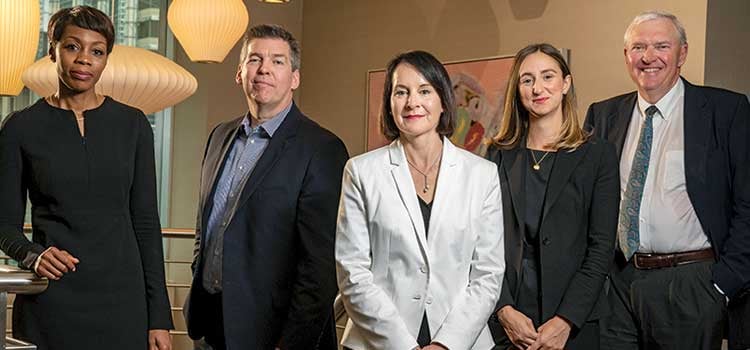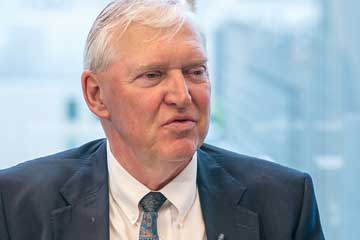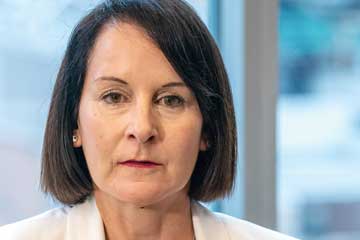For our 13th annual General Counsel Roundtable, we decided to focus the conversation on the impact of technology on in-house departments.

Participants
Kikelomo Lawal
Chief legal officer and corporate secretary, Interac Corp.
Legal team of six lawyers, one articling student and two law clerks.
Gordon Ackroyd
General counsel and corporate secretary, SecureKey Technologies
Recently hired one junior lawyer.
Beth Gearing
Vice president, legal affairs McKesson Canada Corporation
Part of a much larger legal group in McKesson Canada and McKesson Corp., a Fortune 500 company, which supports Rexall Pharmacy Group’s legal needs with lawyers all over the world.
Shelley Babin
Vice president, law and general counsel, Ontario Power Generation
15 full-time lawyers, two contract lawyers and three articling students.
Jeremy Farr
General counsel, corporate secretary, Bank of Canada
Legal team of eight lawyers and two paralegals.
For our 13th annual General Counsel Roundtable, we decided to focus the conversation on the impact of technology on in-house departments. Whether it’s the day-to-day running of, and demands of the business, or looking forward to the impact of blockchain or artificial intelligence, in-house lawyers are feeling the pressure of figuring out what it all means to them, their teams and the business units they serve.
They are dealing with the very basic and the very sophisticated at the same time. On the one hand, the in-house lawyers we spoke to for the roundtable are busy trying to make sure their teams have the technology needed to do their daily work more efficiently. Skype for business has revolutionized productivity for the legal teams at the Bank of Canada, Interac and Ontario Power Generation. While this has provided a more seamless path to collaboration, they all admit the “always on” cultures they work in can mean answers are expected faster than ever before. As Gordon Ackroyd of SecureKey Technologies pointed out, sometimes, one has to press the pause button before issuing an approval on an agreement that was “only drafted 14 minutes ago.”
At the same time, these legal leaders feel the need to explore what emerging technology is going to mean for their business units and how it can empower future transactions.
Beth Gearing of McKesson (Rexall) Canada says she would like to see law firms use artificial intelligence to reduce the cost of due diligence on large transactions. “I think they are getting there on that front and I would be welcoming of a firm interested in using that kind of technology,” she said.
What was exciting to hear was that some of the in-house departments are embracing a process that Richard Brait, general counsel at Siemens Canada, introduced a few years ago — an innovation challenge conducted internally. As Jeremy Farr, general counsel at the Bank of Canada, said, “Part of our risk appetite mandate is to become more innovative, so if you want to do something new, you have to jettison something old or find ways to do it more efficiently and use other technologies to automate.”
This kind of approach is pushing the once-siloed legal team to collaborate with colleagues with different skillsets, such as IT.
If it’s one thing the group seemed to be in agreement about it’s that having centralized systems for information in an-age-of-information overload has become a major challenge. Record retention and retrieval is top of mind for Farr and Gearing as well as Kikelomo Lawal of Interac. A proliferation of systems across a variety of different platforms that don’t communicate with one another has become a major challenge for many organizations. Lack of centralized search prevents efficiency in responding to access to requests for that information. These general counsel are also looking ahead to how they will be able to leverage technology, not, as Lawal says, “for the sexiness of it” but to be able to free them to do “things that matter.”
Babin and Ackroyd are also clearly watching closely what law firms are doing in the tech space. They see them partnering with legal tech entrepreneurs and bringing them into their own incubators and see it as a way to have them do the experimentation they can then benefit from.
I hope you enjoy the full discussion that follows. Visit canadianlawyermag.com/inhouse to view video coverage of the roundtable.
INHOUSE: What is your No. 1 challenge with technology right now?
FARR: I can’t really identify just one; I have to identify two. One is record retention and retrieval. We have a proliferation of systems across a variety of different platforms that don’t communicate with one another. We don’t have a centralized search capability, so, both in terms of responding to access to information and litigation discovery, it has become problematic. Add to that a corporate culture of retaining everything even though it is transitory and doesn’t need to be retained and that’s finally brought the institution to a critical halt in trying to respond effectively and efficiently. We have a major initiative underway of a single data management platform that is being introduced. Probably the biggest change management issue is a one-year retention period with automatic disposal: You either file what you have or you lose it after a year. That’s just being rolled out now.
The other area is driven by our risk management framework and it is third-party risk management. We are using more and more third-party relationships, managed services [and] outsourcing. From an enterprise risk management perspective, we are redesigning our processes, so we have procurement through to the contract phase through to renewal, attestations, certifications and we haven’t really paid a lot of attention to that in the past.
GEARING: I echo the records retention issue. We don’t have a centralized contract management software system. I also think communication is a big one. We’re dispersed all over the country and using technology to stay in touch is a key priority for me. You can’t always have in-person meetings, and dealing with each other just on email or phone calls is sometimes not optimal.

ACKROYD: My challenge is probably a little different than some of the other larger organizations. We don’t have multiple lawyers in different jurisdictions or different offices, but for us, we have a relatively small number of important strategic agreements and contracts, so it’s not about volume for me. But over the last five or six years, with people who have predated me, we have accumulated files of agreements and at what point do you purge or do some retention? I’m also at the point where we are starting to think about what might be an appropriate technology solution for contract management and for contract preparation. We don’t do hundreds and hundreds of agreements, but there’s probably a better way. Historically, people did it all through email, but now there are more text messages with important details about deal terms, so I’m starting to think about a solution that would allow that to be documented and retained so you could pull out an email with key points because it might not find its way into an agreement. So, it’s a matter of finding that balance because we don’t need a full-on solution. I also don’t want to be the first person to try something and get the white elephant nobody wanted.
LAWAL: I would also mention contract management and document management for the lifecycle. Those are huge for us as well. A lot of what we do today is constrained by one form of technology that doesn’t communicate well with another. We have things like a tickler system that require manually inputting the dates that matter. It would be great to have that automated and have that work with some other technology that we use.
BABIN: For me, the biggest challenge is we do all the management of our external firms manually. We use Excel with the firms to track budget and matter management information tracking and then we track that internally. All of our invoicing is done manually, so there is one administrative assistant who spends a large part of her day dealing with managing that process. It makes it quite challenging to have meaningful data and analytics that I can then use to go out and try to negotiate some cost efficiencies with the firms. I have pulled together a team with our external providers and finance team and internal department to figure out how we can do that and determine if there is a technology solution that might help us with that process.
INHOUSE: What about cybersecurity and data breach?
LAWAL: Data is central to what we do. When you’re transmitting financial information as we do, often there is a heightened sensitivity around it. We have both customer information and client information and need to be mindful of that. On top of that we have some personal information, so there are layers to the data protection and data storage issues that we have. There’s been a lot in the news lately about organizations that have been compromised and you never want to be that one. Interac as an organization takes that very seriously, again because of the nature of what we do and that will also manifest in how we handle information for contract purposes.
FARR: Resiliency/systems risk is our biggest risk at the Bank of Canada. We plan on a three-year cycle and we’re just coming to the end of the cycle. For the last three years and for the next three years, resiliency dominates our strategic initiatives. That’s resiliency both from critical systems and recovery. We have a third data centre model with automatic failover and with cyber it’s not only in terms of protecting our own system, but the interconnectedness of the financial system has now become an issue. So, we have a project with the chartered banks, for example, to try and address resiliency within the actual financial system. There is also the whole interdependency — you are only as safe as your weakest link.
ACKROYD: That’s consistent with what we are trying to do. We are in the midst of rolling out, with the co-operation of the seven largest financial institutions and the three mobile players, a digital identity network. It’s critical, like our concierge service, in that we don’t see the clients — it’s a triple-blind model. SecureKey is a concierge service that provides online authentication. It allows you to sign in to a government agency using your banking credentials via online or mobile banking system. We don’t know your information — we never see it. There are identifiers that are transmitted. Now we’re moving to identification verification where there is information shared by a trusted source — how does it get from point A to Point B across an ecosystem network without us seeing it?
The system we are rolling out later this year is an ecosystem — if someone wants to send her information to a company she wants to do business with, it gets there safely without us having the information stored in a database. We’re using blockchain/distributed ledgers. The good news I guess is that every party we’re dealing with is very, very interested and focused on cyber-risk — what is the weakest link? The bad news is every party is really interested — it just makes it difficult because there are different parameters, different standards and technologies.

GEARING: I think we have very strong security and privacy protocols. We’re collecting personal information; not just personal information but personal health information from people, so we’re subject to different privacy laws that deal with collection and use of that information. As an organization, it’s very important for our customers to know their information is protected and safe. Having said that, there is always room for improvement. For example, the collection and storage of data at independent stores is something I think about a lot. Overall, I think our central privacy breach protocols are quite good.
BABIN: Ontario Power Generation doesn’t have any end users, per se, so we’re not like the local distribution companies who would have customer information. Our privacy is focused on employee information, and our cybersecurity needs tend to focus on nuclear security or security and safety of our facilities. We have a robust cybersecurity program in place that’s run by our chief information officer with support from the legal team.
INHOUSE: Is anyone using technology to better manage the legal department, beyond spreadsheets?
FARR: We have a “mobility first” strategy, so everyone has remote access including Skype for business on their laptop and that means they can literally work anywhere and be fully connected — it just automatically happens and that has transformed the way the bank works and not just in the legal department but across the bank. People can work from home or they can work anywhere within the building in collaboration spaces. It sounds trite, but it has made a huge impact on the workforce and in particular the younger workforce that expects that to be there.
LAWAL: We’re working toward a tool that will be multi-purpose. We have a lot of manual systems, but as an organization, there is a movement toward enabling technology that will allow for communications within the organization. We also have Skype for business on everyone’s laptop and that promotes the mobility of working.
BABIN: When I joined the company, nobody had a laptop and remote access only worked sometimes. We are geographically dispersed as an organization and so it really was challenging to be out working with business partners face to face if they didn’t have the ability to be connected, so that has changed. We now have a seamless system and Skype for business, which really does help — it doesn’t clutter up your inbox with PowerPoint presentations, it’s really been a great tool. We also rolled out a document management system last year. It’s not a solution to everything, but it really does help because everyone was using their own way to share documents. Some stored them on SharePoint, some on hard drive and now we have this single source of truth for documents that come through the legal department. We’re trying to make sure that whatever tools we look to help us with organization can have functionality with our DM tool.
INHOUSE: Is anyone working their external law firms using any tools, such as portals to monitor a deal without email?
GEARING: That sounds wonderful, but I think it’s still very underexplored even among some of the larger firms. One thing I would like to see in terms of artificial intelligence is software that reduces the cost of due diligence on large transactions — an algorithm or machine that can read hundreds of thousands of pages of documents and tell you all you need. I think they are getting there on that front and I would be welcoming of a firm interested in using that kind of technology.
FARR: We have electronic billing, so for a law firm to get paid by the Bank of Canada, they submit the invoice electronically and it goes into our financial management system. I still get paper envelopes with billings — I don’t know whether it’s a law society rule, but they are meaningless — they just get ripped up and thrown away. No matter how much you say it, every 30 days you still get those invoices coming through in the mail.
INHOUSE: Does your software provide you any analysis on your billings?
FARR: Yes, it is run through financial services, but we can get, by code, what areas we are spending the most money on and we do use that information. We have selectively hired individual lawyers in-house in order to reduce outside spend and it’s been very successful in some areas.
BABIN: One of the firms we work with provides legal project management and we have asked them to provide dashboards of information about how our money is being spent on certain files. We’re intending to partner with them to figure out if legal project management is something we can deploy more broadly then with just this one firm and use internally and with our other service providers because that data is really fundamental to understanding how we’re spending our money and how we can maybe spend it differently or more efficiently. To the point about AI, I feel there are some firms that are more on the leading edge of these things and they are actually going out and talking to legal tech companies and entrepreneurs and bringing them into their own incubators within the firms and then saying to clients: “We have a tool that may be able to help you with this or with that,” which then means we don’t have to be spending our time figuring out what works. They have already done that work.
GEARING: To your point on project management, at Rexall on major projects, we’ll generally get a project manager involved. We have some of them in-house that have been trained and they don’t necessarily need to be lawyers. On the last major project I was involved with, they set meetings, distributed information, kept track of a due diligence tracker so that other people working on the deal could focus on other things. It was Deloitte that provided one on the last transaction we did — so it doesn’t necessarily need to be a law firm.

ACKROYD: My views are that’s good for the right deal and the right transaction, but I think there are a lot of smaller companies that aren’t doing five M&A deals a year and not using external counsel regularly where they have that rapport with an external law firm where there would be that investment by a law firm. But I think that what is really necessary and essential and it depends at what stage your business is at is contract intake — so how do you create appropriate contracts? I think we need a better way to ask the right questions, get the right inputs to create a better contract and then how to manage that contract and get the information out whether through AI or if you need to know your change of control provisions or something like that. I do think some small legal tech companies are better suited to do that than a big law firm or some of the accounting firms depending on size and scope.
INHOUSE: How would you say technology has changed your job as a lawyer in-house?

LAWAL: I might be dating myself, but if you think about Shephardizing a case . . . the old school way of doing cases, or if you remember when Lexis and Westlaw first came out and if you did a mega, mega search and cringed when the bill would come in and how technology has allowed us to do things more efficiently. We started with things like checklists, then self-help options for business. I think the next phase will be to help us with document generation. At Interac, we have an NDA form — we call it an NDA wizard — it allows you to pull down menus and allows people to generate NDAs themselves, but I think the next phase will be for the business user to say ‘This is what I want to accomplish’ and then it creates the NDA. I look forward to that sort of thing. It would allow legal to focus on the things that matter — the strategic things and that’s my hope — that I will be able to leverage technology not for the sexiness of it but to be able to free me and the people I work with to do things that matter — that require the kind of advocacy and things machines cannot do.
BABIN: We are doing a trial of a Thomson Reuters product — Practical Law [Note: Canadian Lawyer InHouse is a Thomson Reuters publication]. It is something we are considering purchasing because we are hoping to defer some of that more junior work doing case law research to do other things. We’re also hoping it will allow us to do more of that internally as opposed to going to external firms. The product also offers some annotated agreements and can help us just be more efficient in drafting down the road. It also means our dusty library is now gone.
INHOUSE: Do you find technology is invading your work and personal life more?
GEARING: It’s the ability to be connected 24/7 that is challenging sometimes and it’s the pace of it that has changed over the course of my career. Sometimes, you just have to say ‘We have to slow down for a minute and think about this.’ People’s expectations, especially in retail — retail is fast — so that’s one challenge I find in my practice.
FARR: There’s really no time for sober deliberation. The email, once sent, a reply is expected. Two things, too — picking up on your point — our law library is pretty dusty. It’s not really getting used. One example — we have something in compliance . . . a legislative framework and we have identified every statute by business line that applies and we will have each manager certify how their policies and procedures
have been designed to comply with those laws — that would be an absolute gargantuan task, but now with whether Thomson Reuters or Lexis Nexis, you can fill in fields and are aware of every legislative development and are immediately notified if revised or changed or prospectively being amended. I think back to my old Harvard Blue Book days — I don’t know how you could possibly keep up to date with all that now when it’s all available from your laptop.
ACKROYD: Now when you send out an agreement, within 14 minutes there is a reply from your boss asking if we can send it out. So sometimes you have to stop and slow things down. There is contracting by text now — I see it all the time — so I think technology is great in some ways, but you’re just always on and I think we’re expected to be quick and nimble.
LAWAL: It’s a symptom of the world we live in today — just immediacy on all fronts and it manifests in how we have to conduct ourselves. It’s just time and technology marching on, but the practice of law has to march on; it means lawyers have a shorter amount of time to analyze things.
GEARING: I want to echo the shout-out for Practical Law. Especially as a smaller legal department, it’s an incredible resource for a small department or solo legal department. I had to do a mobile app agreement and they had one in a Word document and you can edit it and save it. If somebody calls you on a legal issue, somebody from a major law firm has probably already thought about it and written a memo about it.
INHOUSE: What about blockchain and the impact of AI?
FARR: Obviously, at the Bank of Canada, our whole business is affected by these technologies — we’re monetary policy, financial stability, funds management and currency. All are prime candidates for artificial intelligence with data analytics or distributed ledger technology. We have major research initiatives underway because we know it’s going to impact us, but [we’re] not quite sure how it will impact us. We have big data analytics, which is heavily influenced by artificial intelligence. One of the challenges in the monetary policy space is the digitization of the economy and what that actually means. There is a huge payments modernization process going on and that could easily be impacted by distributed ledger. We’re also researching whether we should be issuing a central bank digital currency and if so just what form it will take. We’re trying to create innovation zones where we partner with private sector enterprises to try to answer common problems. For a public institution, that is more difficult than you think to do because we have procurement rules, fairness in contracting, data that has confidentiality constraints, so how can we effectively partner at the same time as respecting all of those structures. It’s a work in process.
ACKROYD: When I break it down at the end of the day it’s a distributed ledger where we are storing information safely, securely and it’s not in one hub. I think that’s got so many applications and maybe not so much for every company and every law firm, but whether it’s real estate transactions, payments, identity transactions — just think about all the things that make sense, so if you have a private or semi-private ecosystem with a group of people with vested interests, it’s the way of the future. Right now, we’re working with multiple parties to think about what the right guidelines and strategies are to roll out. It’s the No. 1 thing we focus on most days.
LAWAL: To pick up on the AI point, we have used AI at Interac for many years and we use it primarily in connection with fraud mitigation. So we have a fraud scoring engine that helps us reduce the amount of fraud and predict the transactions that are likely to be fraudulent. I joined Interac 10 years ago and that technology was being used. It is continuously being used and shepherded by a group of people who take the information and make the decisions based on the output of the analysis done at the machine. . . For me, it is helpful to see it in action and helps you think of other ways it can have other applications. The applications in payments area are numerous. It’s great to see it in action and helps you see how you can implement it on a smaller scale in your legal department.
FARR: The other element is that the law is still emerging, so we’re in a dangerous space right now. One example is data scrapping. All the technology is there, the data you can mine is phenomenal, but to actually do it you’re actually breaching about every enterprise’s terms of use. We have to find a way to find an equilibrium that everyone can be comfortable doing what they need to do and realize the benefits as well.

BABIN: We use external firms when we have litigation involving a large document production requirement. We’re also subject to Freedom of Information legislation and we’re seeing an uptick in those requests and they are often document-intensive. The firms right now are, generally speaking, offering us a billable-hour model with either an outsourced or in-sourced lawyer sitting and reviewing documents. What I’m hoping is we get to a place where either in partnership or as a department with external providers where they are leveraging some AI to do that big document review and the same on the transactional side with due diligence review.
GEARING: Data analytics is a big topic for us. Development of loyalty programs is a big one. My oversight of that is making sure the data that is analyzed and collected is safe and protected. Those are two giant subjects for us right now. At McKesson, data analytics has been underutilized and they are investing heavily in that going forward.
INHOUSE: Are you seeing different skillsets being brought in to handle these types of projects?
GEARING: I’m seeing at McKesson that a lot of that work is being done by the IT group at McKesson corporate.
ACKROYD: We have a new lawyer and he read up on all of our patents when he was coming in. He gets blockchain and I asked him what he thinks we should be looking at from a new technology point of view, so I had two pages of suggested scenarios. He’s under 30, so everything he has done as a young adult has been with technology. There is an awareness and a comfort level and a savviness.
LAWAL: I have heard the term legal operations a lot and those people are often predisposed to technology and innovation. IT has lots of people thinking about how to move forward the operations and day-to-day processing of information and work.
BABIN: I feel we could use someone like that — it’s kind of my role — general counsel and legal operations. I think it would be of great benefit to have someone dedicated to that legal operations function.
INHOUSE: What do you expect from your firms when it comes to technology?
BABIN: I think the firms are trying to embrace innovation and technology. Certainly, there is a lot happening in the CPD space — it seems every other invitation I get is about innovation or tech. I think they are trying to get their arms around what’s out there to make it more understandable for their clients.
LAWAL: I think there was a time when providing data room ability was as far as law firms would have gone, but I am seeing more offering AI as a tool they would use for transactions. [There’s] a lot more partnering with incubator organizations to try and distinguish themselves.
GEARING: It’s pretty much the old unsexy technologies, Microsoft Office and that kind of thing.
ACKROYD: We don’t use a lot of external counsel, but in a couple of cases, they brought in two small technology players to talk about what they can do to make your world better. I thought that was very useful. They’ve identified the skills gap and instead of trying to hire it and grow it and train them, there are people out there who do this and know what they are doing.
LAWAL: Would you say it’s more about the law firms trying to adapt to the new world to show they are progressive?
BABIN: There is that idea of the disaggregation of legal services and I think the firms are feeling threatened by that. Deloitte can offer services the firms can offer, and they are trying to show they remain relevant with all the other options out there.
GEARING: I think it’s about adding value in a unique way and they become a differentiator.
INHOUSE: What are you doing to make sure your lawyers remain current with technology?
LAWAL: A couple of years ago, we decided to move our CPD in-house and we’ve been really successful at that. We have a legal department manager who polls people about what they feel we should be hearing and learning about, and we have tapped our external firms to provide those trainings and that would be the primary way for us to be conversant in the things happening in the industry and technology that is available.
BABIN: I heard the GC of Siemens Canada [Richard Brait] talk about a legal innovation challenge he did with his team and we’re going to roll something like that out and ask people in the department to come and pitch ideas about what is in the market, what might work for us and, hopefully, that will get people embracing the idea of finding what’s out there and staying current.
FARR: Part of our risk appetite mandate is to become more innovative, so if you want to do something new, you have to jettison something old or find ways to do it more efficiently and use other technologies to automate. We also have an innovation space that is an idea lab, so lawyers will collaborate with people in other departments.
GEARING: We’re doing the same thing with a mind to being more efficient.
ACKROYD: We have some brilliant technology people in our company, so I learn more just talking to them sometimes. We all have our CPD obligations, but I zero in on things that I think will help me learn and get to things that are going to be relevant.










